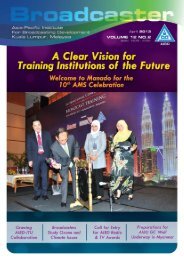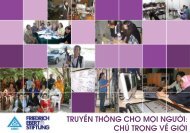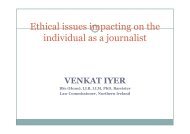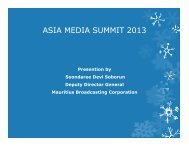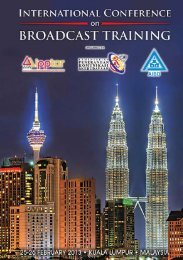Broadcaster
Broadcaster 042012.pdf - AIBD
Broadcaster 042012.pdf - AIBD
Create successful ePaper yourself
Turn your PDF publications into a flip-book with our unique Google optimized e-Paper software.
Asia-Pacifi c <strong>Broadcaster</strong>s Brainstorm on<br />
Linkages Between Ozone Depletion and<br />
Climate Change<br />
<strong>Broadcaster</strong><br />
Fourteen TV producers and directors from<br />
across the Asia-Pacific region recently met<br />
in Kuala Lumpur to explore media’s role<br />
in spreading awareness about the links<br />
between ozone depletion and climate<br />
change.<br />
From February 27-29, 2012, they took<br />
part in a three-day Asia-Pacific Media<br />
Workshop on the Linkages between Ozone<br />
Depletion and Climate Change organized<br />
by AIBD with support from the OzonAction<br />
Programme of the United Nations<br />
Environment Programme – Regional Office<br />
for Asia and the Pacific (UNEP-ROAP).<br />
AIBD and UNEP organized the workshop<br />
to deepen the media’s understanding of<br />
the urgency in reducing the production<br />
and consumption of the chemicals used in<br />
refrigeration and air-conditioning which are<br />
potent greenhouse gases. Asian countries<br />
are the main producers and consumers of<br />
HCFCs, and governments have agreed to<br />
phase them out by 2030.<br />
“Our challenge is to mobilize the airwaves<br />
to communicate these two important issues<br />
on ozone depletion and climate change to<br />
billions of viewers,” said Mr. Yang Binyuan,<br />
AIBD director.<br />
TV producers learnt about ozone science,<br />
the Montreal Protocol, current HCFC<br />
phase-out programs in air-conditioning,<br />
refrigeration and other industries in Asia-<br />
Pacific and climate and energy efficiency<br />
benefits of HCFC phase-out.<br />
The participants learnt about how ozonefriendly<br />
chemicals are potent greenhouse<br />
gases and the need to communicate this<br />
to the mass audience and policy makers in<br />
the Asia-Pacific region.<br />
Fourteen TV producers and directors from<br />
across the Asia-Pacific region recently<br />
met to explore media’s role in spreading<br />
awareness about the links between ozone<br />
depletion and climate change.<br />
Visit of the factory “CycleWorld”<br />
As part of the learning process, they visited<br />
CycleWorld, a Malaysian company that<br />
uses HCFC-141b in the production of rigid<br />
foam. With assistance from the Multilateral<br />
Fund, CycleWorld is shifting to non-HCFC<br />
alternatives in the near future.<br />
Ms. Aminah Ali, assistant director of<br />
the National Ozone Unit at the Ministry<br />
of Environment in Malaysia, served as<br />
a resource person and shared the host<br />
country’s experience in phasing out ozonedepleting<br />
substances (ODS).<br />
This workshop was dedicated to Mr Robert<br />
Lamb (1952-2012), founder director of<br />
Television Trust for the Environment<br />
(TVE), which UNEP set up in 1984. An<br />
internationally renowned environmental<br />
filmmaker, Mr. Lamb excelled in producing<br />
science-based TV programs and other<br />
media products on a wide range of<br />
environment and development issues,<br />
including ozone depletion and climate<br />
change. In 2002, he co-authored a global<br />
communication strategy for the Montreal<br />
Protocol.<br />
(Seated 3rd from right): AIBD director Yang Binyuan<br />
graces closing ceremony<br />
17



